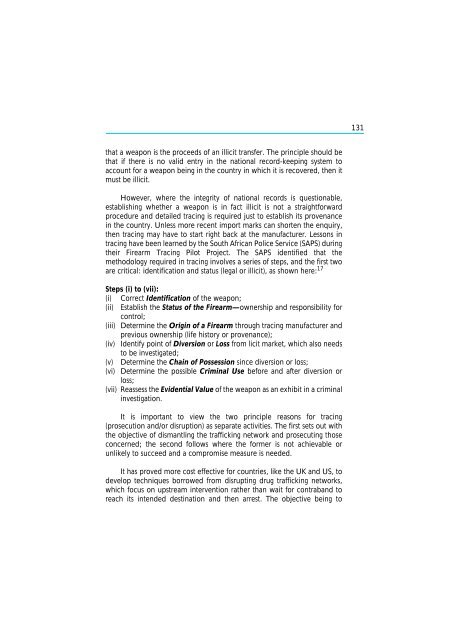The Scope and Implications of a Tracing Mechanism for Small Arms ...
The Scope and Implications of a Tracing Mechanism for Small Arms ...
The Scope and Implications of a Tracing Mechanism for Small Arms ...
Create successful ePaper yourself
Turn your PDF publications into a flip-book with our unique Google optimized e-Paper software.
131<br />
that a weapon is the proceeds <strong>of</strong> an illicit transfer. <strong>The</strong> principle should be<br />
that if there is no valid entry in the national record-keeping system to<br />
account <strong>for</strong> a weapon being in the country in which it is recovered, then it<br />
must be illicit.<br />
However, where the integrity <strong>of</strong> national records is questionable,<br />
establishing whether a weapon is in fact illicit is not a straight<strong>for</strong>ward<br />
procedure <strong>and</strong> detailed tracing is required just to establish its provenance<br />
in the country. Unless more recent import marks can shorten the enquiry,<br />
then tracing may have to start right back at the manufacturer. Lessons in<br />
tracing have been learned by the South African Police Service (SAPS) during<br />
their Firearm <strong>Tracing</strong> Pilot Project. <strong>The</strong> SAPS identified that the<br />
methodology required in tracing involves a series <strong>of</strong> steps, <strong>and</strong> the first two<br />
are critical: identification <strong>and</strong> status (legal or illicit), as shown here: 17<br />
Steps (i) to (vii):<br />
(i) Correct Identification <strong>of</strong> the weapon;<br />
(ii) Establish the Status <strong>of</strong> the Firearm—ownership <strong>and</strong> responsibility <strong>for</strong><br />
control;<br />
(iii) Determine the Origin <strong>of</strong> a Firearm through tracing manufacturer <strong>and</strong><br />
previous ownership (life history or provenance);<br />
(iv) Identify point <strong>of</strong> Diversion or Loss from licit market, which also needs<br />
to be investigated;<br />
(v) Determine the Chain <strong>of</strong> Possession since diversion or loss;<br />
(vi) Determine the possible Criminal Use be<strong>for</strong>e <strong>and</strong> after diversion or<br />
loss;<br />
(vii) Reassess the Evidential Value <strong>of</strong> the weapon as an exhibit in a criminal<br />
investigation.<br />
It is important to view the two principle reasons <strong>for</strong> tracing<br />
(prosecution <strong>and</strong>/or disruption) as separate activities. <strong>The</strong> first sets out with<br />
the objective <strong>of</strong> dismantling the trafficking network <strong>and</strong> prosecuting those<br />
concerned; the second follows where the <strong>for</strong>mer is not achievable or<br />
unlikely to succeed <strong>and</strong> a compromise measure is needed.<br />
It has proved more cost effective <strong>for</strong> countries, like the UK <strong>and</strong> US, to<br />
develop techniques borrowed from disrupting drug trafficking networks,<br />
which focus on upstream intervention rather than wait <strong>for</strong> contrab<strong>and</strong> to<br />
reach its intended destination <strong>and</strong> then arrest. <strong>The</strong> objective being to
















